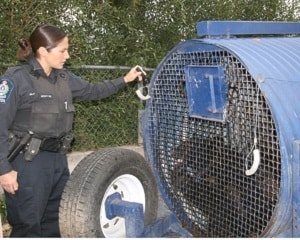He paws at the cage and yawns.
“This is a relatively small bear,” Conservation officer Ryane McIntyre says, shinning a penlight into the bear trap.
“He’s about two or three years old.”
The bear eyes us from the bars and makes a loud huffing noise. It’s intimidating, surprisingly loud and followed by a popping sound.
“He’s showing us his dominance,” McIntyre explains.
“It’s his way of showing his aggression.”
This is not the first bear this season McIntyre has been forced to destroy, in fact it’s number 11 in a month.
The animal in her trap, Tuesday morning, was caught the previous evening in the West Fraser Road area.
Titled a “problem” bear, it had laid claim to a food source in a resident’s yard. That food source was a fruit tree, one of the most common attractants of wildlife – and one of the main reasons McIntyre is forced to destroy the animal.
“That’s the only thing I can do,” she said.
“We do not relocate the animal.”
Which is why McIntyre says education is pivotal. Conservation regularly hands out information in neighbourhoods experiencing bear sightings.
The two biggest concerns lie with proper garbage storage and maintaining fruit trees.
“You have to hack it down or prune it right back,” McIntyre explained.
As for garbage, it needs to be stored, just prior to disposal at a designated facility.
Sounds easy enough, but many residents fail to comply, resulting in Conservation handing out Dangerous Wildlife Protection Orders.
The order specifies action and gives a strict timeline for compliance. If compliance is an issue, the culprit is slapped with a fine to the tune of $575.
Since September, Quesnel Conservation has received more than 193 calls, from all areas of the city.
“We currently have two family units in Southhills, a unit in Red Bluff, a couple of sightings in Dragon Lake, a family unit in Bouchie Lake, sightings in Hixon, Carson and Johnston Sub, West Fraser and Kersley... they’re kind of everywhere,” she said.
Once bears have become a “nuisance” or have “claimed” a food source, McIntyre is forced to attend the scene, remove the bear and destroy it.
Hence the need for compliance.
“People need to simply start taking responsibility,” she said.
“It’s your tree, it’s your garbage, it’s your problem – clean it up.”
McIntyre also recommends using bear horns, bear bangers (or pots and pans), tagging the bear with a paintball gun, or a slingshot – all as deterrents if a bear is spotted on your property.
“Lastly, regarding dogs, have the dog restrained and/or call it back if it pursues the bear,” she said.
“Sows will fight to the death to protect their cubs.”
For more information, www.bearaware.bc.ca and www.env.gov.bc.ca/cos/info/bearaware/index.html.
